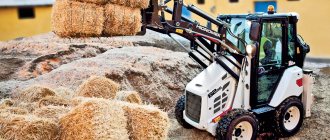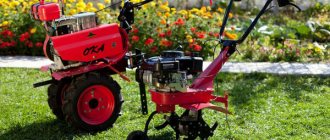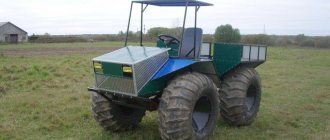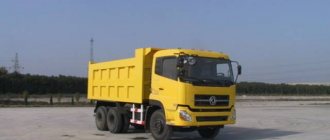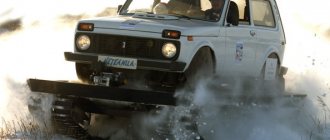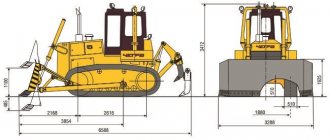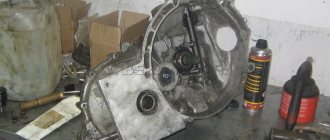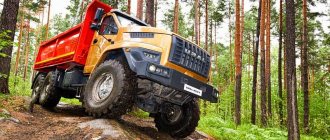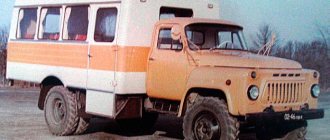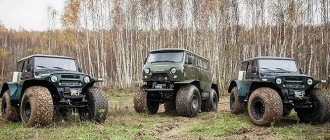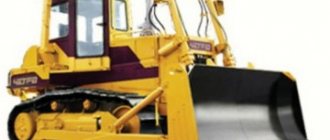The GT-TR "Maral" tracked all-terrain vehicle is designed for transporting goods and people over rough terrain. The sealed supporting body allows you to overcome water obstacles; you do not need to leave the car to service the engine and transmission units. The snow and swamp-going vehicle is based on the modernized GT-T chassis, developed in the late 50s. last century.
All-terrain vehicle GTT: history of creation and development
In the 1950s, intensive development of various remote areas of the country took place in the USSR. Existing wheeled vehicles, despite continuous improvement, were unsuitable for movement in difficult climatic and road conditions. The country and the army needed an all-terrain vehicle that could withstand operation at ambient temperatures from minus 45 degrees to plus 45.
Making a machine
In such conditions, the most suitable vehicle was a special purpose tracked all-terrain vehicle. The development of a universal tracked tractor was carried out at KhTZ (Kharkov Tractor Plant) under the in-plant designation “project 21”. The design stage took about four years, and in 1961 the first two products were assembled. The car received the designation GTT and since the spring of 1962 it was mass-produced at the Rubtsovsky Machine Plant. The main customer of the tractor was the army.
The characteristics of the GTT all-terrain vehicle made it possible to abandon the operation of a number of non-tracked tractors, thereby simplifying the maintenance and supply of spare parts to vehicle fleets in remote areas of the country. The vehicle, with its own weight of just over 8 tons, could transport up to 2 tons of cargo. If necessary, the cargo compartment measuring 3.5 m * 1.8 m could accommodate 21 people. The all-terrain vehicle was equipped with a coupling device for towing trailers with a total weight of up to 4 tons.
Hull and chassis design
The body of the GTT all-terrain vehicle had a supporting structure and was manufactured by welding. The body had a power frame to which the outer sheets were attached. Since one of the customer requirements was to ensure buoyancy, the lower part of the vehicle was sealed.
Inside there were two bulkheads that divided the hull into three compartments - power unit, passenger and cargo compartments. The gearbox and onboard clutches were located in the bow of the GTT all-terrain vehicle, the engine was located closer to the central part of the passenger cabin of the body. To the left of the engine casing was the driver's seat. It was separated from the nasal part by a partition. Behind the mechanic and to the right of the engine there were three more passenger seats.
The cargo compartment was located behind the engine and did not have a partition with the passenger compartment. The compartment was open and could be covered with a tarpaulin awning.
The chassis of the GTT all-terrain vehicle had six road wheels per side. The rollers had external shock absorption in the form of a rubber ring on the outside of the roller. The drive wheels with a toothed rim were located at the front. The caterpillar consisted of 92 tracks connected by floating fingers. The tracks were tensioned using a movable guide wheel located at the rear.
The suspension of the road wheels is torsion bar. Movement afloat was ensured by the rotation of the tracks and was facilitated by special removable shields.
Tractor transmission
The power unit on the GTT tracked all-terrain vehicle was a 200-horsepower diesel engine model B6A. The inline six-cylinder engine was half of the famous B2 tank engine. Due to its tank origin, the engine had a combined starting system - from an electric starter and compressed air. Fuel consumption was quite high - up to 110 liters per 100 km.
The engine was equipped with a five-speed manual gearbox. To make a turn on the GTT all-terrain vehicle, partial or complete braking of one of the tracks using friction clutches was used. The final drives were equipped with planetary gearboxes. The maximum speed did not exceed 45 km/h forward and up to 6.5 km/h back.
Modifications and development
In the first years, production proceeded at an accelerating pace. By the mid-60s, the plant assembled up to 120 cars monthly. At the end of the 60s, a civilian version of the GTT all-terrain vehicle appeared - a timber-floating vehicle. In addition to it, there was a version of the GTTS, equipped with a fifth wheel coupling from the ZIL-157V truck tractor.
By the end of the 70s, the production of gas turbine engines was completely transferred to Semipalatinsk (Kazakhstan) to a branch of the Rubtsovsky plant.
In the 90s, work was underway to modernize the machine. In particular, they installed a more economical and modern YaMZ-238 diesel engine. The car received the designation GTTB. The engine itself was moved back somewhat, increasing the accommodation conditions for passengers. But thanks to the new engine, the load capacity increased to 2,500 kg, and the maximum speed to 50-55 km/h.
At the same time, the material of the shock-absorbing rings of the road wheels was changed to a more wear-resistant polyurethane.
In 2007, an extended version with seven road wheels appeared under the designation GTTBU. This version of the machine is currently being produced.
fb.ru
Specifications
The body of the all-terrain vehicle is welded from steel sheet; frames are provided inside for installing a diesel engine and transmission units. The vehicles use naturally aspirated 240-horsepower versions of the YaMZ-238 diesel engine; some versions use a supercharged modification that develops up to 310 hp. The power flow is transmitted via a dry friction clutch to a 5-speed gearbox, which is connected by shafts to the final drives.
The drive wheel is located at the front; a toothed ring is used to engage the tracks, which can be replaced with your own hands.
Antifreeze is used to cool the engine, circulation is carried out by a pump. The heated liquid is used to heat the cabin; installation of autonomous heaters is provided. The chassis includes support rollers with a monolithic rubber ring on the end edge. The rollers are mounted on torsion bars, and hydraulic shock absorbers are provided on the end axles. The track tension is adjusted by a crank on which the rear idler wheel is mounted.
Main technical parameters (using the example of the Argut drilling rig):
- curb weight - 14200 kg;
- number of places - 3;
- machine length - 7900 mm;
- width - 3150 mm;
- height - 3100 mm;
- maximum speed on land - 45 km/h, afloat - up to 6 km/h;
- diesel power YaMZ-240BL - 300 hp;
- ground clearance - 450 mm;
- Cruising range without refueling is 700 km.
A drilling rig with a set of augers with a diameter of 118 or 135 mm is mounted on the all-terrain vehicle. When drilling geophysical wells, compressed air with a pressure of up to 1.5 MPa is used, which is supplied by a compressor installed on the machine. The depth of work reaches 100 m.
Crawler transporter-tractor GTT and its features | All-terrain vehicle, snowmobile, swamp vehicle!
Feb 27 • All-terrain vehicles, Amphibious all-terrain vehicles, Tracked vehicles, Interesting! • • 2 comments on the entry Tracked transporter-tractor GTT and its features
Special-purpose tracked vehicles, such as the GTT tractor-transporter, were developed and released in the late 50s, due to the need to explore hard-to-reach areas. With its appearance, it stopped the production of numerous models of non-tracked tractors, as it had many undeniable advantages. The most important thing was the possibility of operation in areas where it is impossible to use wheeled all-terrain vehicles, in the far regions of Siberia, the Arctic, the Far North, and Central Asia. This full-fledged amphibious all-terrain vehicle, in tests with similar models, has established itself as a fast, reliable, floating all-terrain vehicle with high maneuverability, able to cope with tasks at any time of the year, in extreme temperatures, in areas with steep inclines and slopes.
The GTT tracked transporter-tractor is a snow and swamp-going vehicle and its main purpose is to work in areas with difficult soil and climate conditions. An all-terrain vehicle of this type is used to transport various cargoes, as well as people, in off-road conditions, snowy, swampy areas, in the polar and northern regions, where civilian all-terrain vehicles are often useless. The all-terrain vehicle overcomes off-road conditions, both sandy and swampy, and heavy snow drifts. This all-terrain vehicle on caterpillar tracks has excellent maneuverability when moving in wooded areas between trees. Based on the classification, it can be characterized as an all-terrain vehicle on caterpillar tracks of intermediate (medium) weight categories, and based on this, when creating an all-terrain vehicle of this type, other requests were taken, in contrast to tracked all-terrain vehicles of tractors of other categories.
It is possible to highlight a number of features inherent in GTT.
Make yourself a tracked all-terrain vehicle in 15 minutes!advertising
1. The GTT tracked transporter tractor is a floating all-terrain vehicle that can easily overcome ponds, rivers and other water obstacles. The amphibious all-terrain vehicle provides movement along the surface of reservoirs with caterpillar propellers. To increase their speed on the surface of the water, they use hydrodynamic type flaps; on some models they are removable.2. Thanks to the independent torsion bar suspension, the all-terrain vehicle can move over very rough terrain without experiencing any loss in speed.3. The all-terrain vehicle has a load-bearing body consisting of an all-metal welded frame that forms the structure, the difference being a hermetic base and an open body. The car body is divided into the body part, the cabin and the engine and transmission compartment. The latter is located at the very beginning of the hull and is fenced off from the cabin itself. The body of an all-terrain vehicle is located in the rear; the cabin is located in the middle; since they have no separation from each other, the body is often covered with a partition made of tarpaulin. The engine itself is located in the central part of the cabin and has guards; on the left there is a place for mechanics and control instruments that transmit forces from the engine to the propulsion unit.4. The GTT tracked transporter tractor has a six-cylinder four-stroke diesel engine B 6A, the fuel is ignited by compression and is directly injected into the cylinders, which are located in a vertical position one after another. The power of such a motor is over 200 hp.5. GTT has two additional mechanisms that are used for turns. A crawler-mounted all-terrain vehicle makes a turn by disconnecting one caterpillar belt from the power transmission, while the second “caterpillar” continues to work with the transmission, maintaining force and turning the vehicle. In order to realize this, the designers equipped the tracked conveyor-tractor with two turning mechanisms, which are located between the main and final drives: friction clutches, a mechanism operating using friction force, and a planetary mechanism. The all-terrain vehicle can easily turn in one place.6. The gearbox is manual and includes five gears, not counting one reverse. It can reach a maximum speed of up to 47 km/h, in reverse gear up to 7 km/h.
Crawler conveyor-tractor GTT and its features modification GT-TS
There are various modernized configurations of this all-terrain vehicle, which vary greatly in appearance and pricing policy, year of manufacture; it also matters whether the all-terrain vehicle is mothballed or not, how correctly it was mothballed. Manufacturers of tracked transporters of GTT tractors far-sightedly provide for further installation of auxiliary equipment on their special equipment and machine tools The most common modifications that can be created on the base chassis of a tracked all-terrain vehicle: various installations for drilling wells, a transportable welding installation, a crane, power line maintenance and repair towers, etc. But it is not always possible to anticipate all the needs and requests of the client, but In this case, companies come to the rescue that can modernize, as well as help preserve the all-terrain vehicle, and carry out diagnostics if you decide to buy an all-terrain vehicle from conservation.
February 2015
Gordon Stanislav Semenovich for News 94
Look at the Technical Specifications of the GTT Crawler Transporter Tractor
amphibianOff-road Swamp vehicleAll-terrain vehicleMilitaryTracksfloatingPassabilitySnow
Related Posts
About the author: admin
"North. Young woman. Snowmobile Tactico - Technical characteristics of all-terrain vehicles "TRECOL" and their modifications »
xn—-btbbfdadcbcr9cwalfbbaa4c3a7co.xn--p1ai
Crawler all-terrain vehicle GTT | All-terrain vehicles
The GT-T (GTT) all-terrain vehicle is designed for transporting people and cargo in off-road conditions, snow drifts, and on very rough terrain with deep water obstacles.
The tracked transporter-tractor (GTT) was created in the late 1950s. It was after the development of the GT-T that the development of wheeled all-terrain vehicles was stopped in the USSR.
The tracked transporter-tractor is designed for transporting people and various cargoes off-road in conditions of snow-covered virgin wooded and swampy terrain in the Arctic and Far North regions, in very rough terrain with the presence of deep water barriers and shallow vegetation. The GTT all-terrain vehicle can be operated in winter at extreme temperatures.
The independent torsion bar suspension makes it possible to move over rough terrain at high speed.
The conveyor overcomes water obstacles afloat.
The conveyor has high maneuverability when moving in the forest between trees, in difficult terrain, replete with steep climbs and steep rolls.
The GTT tracked all-terrain vehicle is adapted for operation in winter at extreme temperatures in the Far North and Siberia. The ability to confidently move the GTT all-terrain vehicle over rough terrain at high speed is ensured by an independent torsion bar suspension. The GTT tracked transporter tractor has high maneuverability when driving in off-road conditions with steep climbs and lateral rolls, and the tractor overcomes water obstacles afloat.
The GT-T all-terrain vehicle can be used as a base chassis for mounting various technological equipment.
Technical characteristics of the GT-T tracked all-terrain vehicle (GTT):
| Characteristics | Meaning |
| Weight in running order, kg | 8200 |
| All-terrain vehicle load capacity, kg | 2000 |
| Weight of towed trailer, kg | 4000 |
| Average specific ground pressure, kg/cm | 0,24; 0,20* |
| Base, mm | 3914 |
| Ground clearance, mm | 450 |
| Track, mm | 2600 |
| Overall dimensions of the GTT all-terrain vehicle: | |
| Length, mm | 6340 |
| Width, mm | 3140 |
| Height, mm | 2160 |
| Engine power, hp | 200 |
| Maximum speed, km/h. | 45,5 |
| Number of gears | 5 + 1z.x. |
| Maximum speed afloat, km/h. | 6 |
| Number of seats: | |
| In the cockpit | 4 |
| In the back | 21 |
| Fuel range, km | 500 |
| Fuel tank capacity (l) | 550 |
| Fuel consumption (l per 100km) | 90-110 |
| Turning radius (m) at: | |
| In 1st gear | 6,65 |
| In 3rd gear | 11,4 |
| In 4th gear | 16,9 |
| In 5th gear | 23,4 |
| Z.H. | 3,35 |
| Internal body dimensions, mm | 3500 x 1800 |
| Batteries | 6STEN-140M; 6MST-140; 6ST-190 |
| Diesel fuel | "L", "Z", "A" |
| Operating temperature | from -45С° to +45С° |
Production:
Russia
tundralet.ru
All-terrain vehicles GTT
ChelTehGaz LLC sells GTT all-terrain vehicles .
The tracked transporter-tractor was developed back in the middle of the 20th century. It was after the development of the GT-T that the development of wheeled all-terrain vehicles was stopped in the USSR.
The tracked transporter-tractor is designed for transporting various cargo off-road in snowy virgin lands, wooded and swampy areas, in the Arctic, Far North, Siberia and Central Asia. The independent torsion bar suspension makes it possible to move over rough terrain at high speed. The conveyor overcomes water obstacles afloat. It has high maneuverability when driving in difficult terrain with steep climbs and lateral rolls.
The tractor is also designed for transporting people and cargo in off-road conditions, snow drifts, on very rough terrain with deep water barriers and shallow vegetation. The GTT all-terrain vehicle can be operated in winter at extreme temperatures.
• Independent torsion bar suspension makes it possible to move over rough terrain at high speed; • The conveyor overcomes water obstacles afloat; • The conveyor has high maneuverability when moving in the forest between trees, in difficult terrain, replete with steep climbs and steep banks.
On the basic chassis of the GTT, it is possible to create various modifications with the installation of the following equipment:
• Installation of a crane • Drilling rig for drilling wells, diameter 300 mm for power line supports • Technical lifting tower for repair and maintenance of high-voltage power lines • Fire extinguishing installation • Truck tractor for transporting long loads (pipes) • Mobile welding installation For questions To purchase GTT snow and swamp-going vehicles, please contact ChelTehGaz LLC:
tel, 8-912-891-45-02, tel/fax: (351) 726-56-66, 776-19-21, e-mail
Main technical characteristics of GT-T:
| 1 | Conveyor type | GT-TB |
| 2 | Curb weight | 8500 kg |
| 3 | Load capacity | 2500 kg |
| 4 | Maximum towed trailer weight | 5000 kg |
| 5 | Number of seats in the cabin (depending on modification) | 2-4 people |
| 6 | Dimensions Length Width Height | 6320 mm 3140 mm 2185 mm |
| 7 | Specific ground pressure | 0.24 kgf/cm2 |
| 8 | Ground clearance | 450 mm |
| 9 | Engine Power | YaMZ-238M2 240 hp |
| 10 | Maximum speed | 53 km/h |
| 11 | Speed afloat | 6 km/h |
| 12 | Power reserve | 500 km |
tel., 8-912-891-45-02, tel./fax, 776-19-21, e-mail
GTS - domestically produced all-terrain vehicle
The territories of Russia for the most part consist of difficult-to-pass areas. And it is simply impossible to cross them in ordinary cars. So you have to purchase special equipment that can overcome any obstacles. The GTS tracked all-terrain vehicles became a prominent representative of such equipment.
Where it all started
The Second World War showed the citizens of the country how important it is to have equipment that can travel over any terrain. Therefore, after the war, designers and engineers began to develop all-terrain vehicles. Of course, they were not preparing for war. It was planned to use the technology to develop the northern lands of the country.
And the efforts brought success. Already in 1954, the first copies of the GTS were presented. The all-terrain vehicle had a front-mounted cabin, a section for the engine and a cargo platform. The model was produced at the Gorky Automobile Plant. There, this model received the factory name GAZ-47. The development was based on the production of military equipment. More precisely - T-60 and T-7 tanks.
The model was named after the first letters of the words that indicate the vehicle's affiliation - a tracked snow and swamp-going vehicle.
All-terrain vehicle capabilities
It was not in vain that the designers spent three years developing the project. The GTS all-terrain vehicle, the characteristics of which made it unique at that time, was worth such efforts. It had the best cross-country ability among vehicles at that time. Even tanks got stuck in swamps or sands. The developers took these shortcomings into account. As a result, the all-terrain vehicle received wider tracks. Each of them was increased by thirty centimeters. This technique reduced the pressure of the equipment on the soil. The GTS was able to overcome not only swamps, but also snow drifts.
And water is not a hindrance for hydraulic structures. The all-terrain vehicle is capable of fording a river with a small current. The depth should not exceed one hundred and twenty centimeters. True, the distance is limited to one and a half kilometers. Under such conditions, the snow and swamp-going vehicle can overcome water obstacles without additional preparation. At the same time, its speed is regulated due to the work of the tracks. If the speed of the river flow is very high, the GAZ-47 loses stability due to the large underwater area. There was a possibility of heeling and flooding if the equipment approached the shore broadside. The all-terrain vehicle could only get to land in places with a gentle slope not exceeding twenty degrees.
In addition, the GTS (all-terrain vehicle) is capable of overcoming a slope of sixty percent, a ravine 1.3 meters wide, and a wall with a height of sixty centimeters.
Application area
All-terrain vehicles GTT and GTS were developed specifically for operation in harsh climatic conditions. For this purpose, the equipment was produced with improved performance capabilities and increased reliability. Snow and swamp-going vehicles successfully worked in the Northern, Far Eastern, Siberian regions, Central Asia and even Antarctica. They could even be transported there by air using An-12 or Il-76 aircraft. The temperature at which it is possible to operate the machine is represented by a range from minus forty to plus fifty degrees.
GAZ-47 was successfully used in the military sphere. In addition, the all-terrain vehicle is widely used in construction, geological and scientific research, during the construction and use of oil and gas pipelines, and during rescue operations. Another area of application is the transportation of goods in trailers weighing up to two tons.
Machine Features
The all-terrain vehicle (all-terrain vehicle) differs in that the power unit and transmission are located in the bow of the vehicle. In addition, the drive is also front-wheel drive.
The body is all metal. Its main elements are an engine compartment, a cabin with two doors, and a cargo area with an awning. The cabin heating system is interesting. A fan heater is installed for heating. But its blades are bent in the opposite direction. Due to this, air is not pushed out of the cabin. On the contrary, cold air is drawn into the radiator system. There it heats up and enters the cabin.
Specifications
It had an all-terrain vehicle (all-terrain vehicle) with the following dimensions: length 4.9 meters, width 2.4 meters and height two meters. At the same time, the road clearance was forty centimeters.
The all-terrain vehicle was equipped with a six-cylinder four-stroke carburetor engine GAZ-61. It produced a power of eighty-five liters. The gearbox had one reverse and four forward speeds. To start the engine, an electric starter, pneumatics and a 24-volt battery are installed.
Torsion bar suspension. It is made in the form of five rollers, which improve the performance characteristics of all-terrain vehicles. They are made from a mixture of rubber and mineral substances.
The GTS all-terrain vehicle is capable of speeds of up to 35 kilometers per hour on solid soil, ten kilometers per hour on snow and four kilometers per hour on water. There is enough fuel in the tank for 400 kilometers.
fb.ru
Modifications
GT-TR
— Transporter equipped with an all-metal cargo-passenger body (“Maral”)
- GT-TR-01
— Conveyor with an open loading platform - GT-TR-02
— Transporter-tractor tractor - GT-TR-03
- Transporter equipped with a cargo-passenger body with a removable awning - GT-TR-04
– Fuel tanker (“Skif”) - GT-TR-05
— Conveyor equipped with watering equipment - GT-TR-06
- Conveyor equipped with snow removal equipment - GT-TR-07
— Conveyor equipped with fire-fighting equipment - GT-TR-08
- Conveyor equipped with equipment for reclamation of oil-contaminated lands - GT-TR-09
- Conveyor equipped with emergency rescue equipment - GT-TR-10
- Conveyor designed for winterizing winter roads, cargo-passenger version (“Tegerek”) - GT-TR-11
— Conveyor equipped with a removable water tank - GT-TR-12
— Conveyor with autonomous drilling rig PBU-2 and welding unit 4004.3 (“Argut”) - GT-TR-13
- Transporter with a luxury interior (sleeping cabin with 4 seats, kitchen block) - GT-TR-14
– Tracked repair shop (“Parm”) - GT-TR-15
— Mobile pile driving machine
GTT
Photo Nomenclature number Part name Unit of Measurement Weight
| 21.07.011 | Oil tank assembly 07/21/011 | PC | 22.40 |
| 21.03.022 | Fuel tank assembly 21.03.022 | PC | 26.44 |
| 21.08.021 | Compressed air cylinder 08/21/021 | PC | 15.00 |
| 21.10.169 | Leading drum 10/21/169 | PC | 5.23 |
| 21.10.022 | Left driven drum 21.10.022 | PC | 9.68 |
| 21.10.033 | Driven drum right 21.10.033 | PC | 9.68 |
| 21.11.109 | Brake drum 21.11.109 | PC | 8.50 |
| 21.02.060 | Expansion tank 21.02.060 | PC | 2.24 |
| 21.30.104 | Bolt (M16*1.5) 21.30.104 | PC | 0.07 |
| 21.11.178-1 | Bolt 21.11.178-1 | PC | 0.07 |
| 21.30.104-1 | Bolt 21.30.104-1 | PC | 0.07 |
| 21.30.104-1 | Bolt with nut 21.30.104-1 | PC | 0.07 |
| BNP-M10x20-P8 | Roller cover bolt BNP-M10x20-P8 | PC | 0.07 |
| BNP-M16x35-P8 | Torsion bar bolt BNP-M16x35-P8 | PC | |
| 21.11.011 | Final drive left 11.21.011 | PC | 101.19 |
| 21.11.012 | Final drive right 11.21.012 | PC | 102.36 |
| 21.10.108 | Val 21.10.108 | PC | 38.79 |
| 21.10.105 | Main shaft 10/21/105 | PC | 6.71 |
| 21.10.012 | Main shaft assembly 10/21/012 | PC | 62.05 |
| 21.10.160 | Left cardan shaft 21.10.160 | PC | 4.52 |
| 21.10.160-1 | Right cardan shaft 21.10.160-1 | PC | 5.14 |
| 21.10.108-5 | Primary shaft 21.10.108-5 | PC | 6.40 |
| 21.10.017-2 | Primary shaft assembly 21.10.017-2 | PC | 3.45 |
| 21.10.011 | Transmission shaft assembly 10.21.011 | PC | 38.79 |
| 21.10.049 | 4-5 gear shift roller 10/21/049 | PC | 1.33 |
| 21.10.104 | Transfer shaft 21.10.104 | PC | 13.95 |
| 21.10.108 | Primary shaft with bevel gear 10.21.108 | PC | 6.40 |
| 21.10.117 | Primary shaft with driven bevel gear 10.21.117 | PC | 3.45 |
| 21.30.101-1 | Drive wheel crown 21.30.101-1 | PC | 9.80 |
| A5.01.105-4 | Engine mounting sleeve A5.01.105-4 | PC | 5.90 |
| 21.32.110 | Spacer bushing 21.32.110 | PC | 0.28 |
| A5.40.508 | Large bushing A5.40.508 | PC | 0.20 |
| A5.40.507 | Small bushing A5.40.507 | PC | 0.20 |
| A5.32.115 | Spacer sleeve small A5.32.115 | PC | 0.26 |
| 21.31.113 | Split bushing 21.31.113 | PC | 0.42 |
| 21.31.114 | Fork 21.31.114 | PC | 1.83 |
| A5.31.117 | Tension screw assembly A5.31.117 | PC | 1.60 |
| A5.31.117 | Tension screw A5.31.117-1 | PC | 1.30 |
| 21.10.148 | Carrier MP 21.10.148 | PC | 7.87 |
| 21.11.103 | Carrier BP 21.11.103 | PC | 20.80 |
| 21.10.140 | Transfer shaft nut 21.10.140 | PC | 0.33 |
| A5.32.118 | Castle nut A5.32.118 | PC | 0.33 |
| 5.23.116 | Stop brake adjusting nut 5.23.116 | PC | 0.03 |
| G-74 | Generator G-74 | PC | 46.50 |
| G-731 | Generator G-731 | PC | 62.00 |
| 21.01.001-2 | Main gear 21.01.001-2 | PC | 348.50 |
| 21.01.011 | Main clutch 01/21/011 | PC | 100.70 |
| 21.10.109-2 | Bearing seat 21.10.109-2 | PC | 2.48 |
| 21.34.001 | Track assembly (184 links) 21.34.001 | set | 1740.00 |
| 21.42.044 | Cabin door right 21.42.044 | PC | 15.64 |
| 21.42.086 | Left cabin door assembly 21.42.086 | PC | 15.64 |
| 21.42.087 | Right cabin door assembly 21.42.087 | PC | 15.64 |
| 21.01.010 | Engine V-6A 01/21/010 | PC | 815.00 |
| GTT clutch disc | PC | 0.50 | |
| 5.10.177 | Driven clutch disk 5.10.177 | PC | 0.28 |
| 5.10.176 | Drive clutch disc 5.10.176 | PC | 0.30 |
| 21.10.023 | Pressure disk assembly 21.10.023 | PC | 1.46 |
| A5.32.131 | Driver disk A5.32.131 | PC | 1.46 |
| A5.32.029 | Driver disk assembly A5.32.029 | PC | 1.79 |
| 21.10.024 | Squeeze disc assembly 21.10.024 | PC | 1.79 |
| 21.32.155 | Lever axis plug 21.32.155 | PC | 0.06 |
| 21.42.054 | Left door lock 21.42.054 | PC | 0.43 |
| 21.42.054 | Right door lock 21.42.055 | PC | 0.43 |
| 21.34.101-1 | Caterpillar link 21.34.101-1 | PC | 9.50 |
| 21.10.018 | Final drive housing 10/21/018 | PC | 78.13 |
| 21.11.021 | BP crankcase with crown 11/21/021 | PC | 23.60 |
| 21.09.028 | Air filter cassette 21.09.028 | PC | 2.59 |
| 21.32.023-3 | Support roller 21.32.023-3 | PC | 51.70 |
| 21.30.001 | Drive wheel 21.30.001 | PC | 58.61 |
| 21.31.023 | Guide wheel 21.31.023 | PC | 35.01 |
| 21.31.023 | Guide wheel with axle 21.31.023 | PC | 35.01 |
| 21.31.001 | Guide wheel with axle and tensioner assembly 21.31.001 | PC | 63.45 |
| 21.21.021 | Gear shift column 21.21.021 | PC | 6.48 |
| 21.21.022 | Gear shift column with traverse assembly 21.21.022 | PC | 0.18 |
| 21.23.102 | Tape block MP 21.23.102 | PC | 0.40 |
| 21.23.111 | Brake band block 21.23.111 | PC | 0.67 |
| 21.05.023 | Heater boiler assembly 21.05.023 | PC | 11.94 |
| A5.32.105-1 | Labyrinth ring for lever axis A5.32.105-1 | PC | 0.20 |
| A5.32.031 | Pressure ring A5.32.031 | PC | 0.90 |
| A532.125 | Fixed ring A5.32.125 | PC | 0.70 |
| 21.10.158 | Spacer ring 21.10.158 | PC | 0.13 |
| A5.31.121 | Retaining ring A5.31.121 | PC | 0.70 |
| 21.32.157 | O-ring 21.32.157 | PC | 0.005 |
| A5.32.112 | O-ring A5.32.112 | PC | 0.01 |
| 21.31.112 | O-ring 21.31.112 | PC | 0.00 |
| A5.32.134 | Pressure ring A5.32.134 | PC | 0.10 |
| A5.32.143 | Thrust ring A5.32.143 | PC | 0.10 |
| Glass | Set of windshields (side 2, middle 1) | set | 3.10 |
| 21.10.025 | Left drive box 21.10.025 | PC | 2.21 |
| 21.10.026 | Drive box right 21.10.026 | PC | 2.21 |
| 21.07.023 | Reducing valve 21.07.023 | PC | 1.50 |
| 21.02.022 | Steam-air valve 21.02.022 | PC | 0.18 |
| 5.21.047-1 | Bracket for vertical rollers, assembled 5.21.047-1 | PC | 5.50 |
| 5.11.148-1 | Drive wheel cover 5.11.148-1 | PC | 0.08 |
| 21.32.025 | Roller cover 21.32.025 | PC | 0.71 |
| 21.41.014 | Towing hook 21.41.014 | PC | 12.57 |
| 21.23.022 | Brake band MP 21.23.022 | PC | 2.30 |
| 21.23.023 | Friction tape MP 21.23.023 | PC | 3.24 |
| 21.23.026 | Stop brake band assembly 21.23.026 | PC | 5.05 |
| 21.10.013 | Left turning mechanism 10/21/013 | PC | 23.80 |
| 21.10.014 | Right turning mechanism 10/21/014 | PC | 23.80 |
| 21.22.085 | Left control bridge 21.22.085 | PC | 8.25 |
| 21.22.084 | Right control bridge 21.22.084 | PC | 8.31 |
| 21.10.133-1 | Gear clutch 1st reverse gear 21.01.133-1 | PC | 2.10 |
| 21.10.134 | Gear coupling 2nd and 3rd gears 10.21.134 | PC | 1.73 |
| 21.10.135 | Gear clutch 5.10.135 | PC | 0.880 |
| 21.10.136 | Gear coupling 4th and 5th gears 10.21.136 | PC | 1.55 |
| 21.11.184 | Gear coupling 21.11.184 | PC | 1.38 |
| 21.01.117 | Gear coupling 21.01.117 | PC | 2.00 |
| 21.10.103-1 | Gear coupling 21.10.103-1 | PC | 2.02 |
| 21.10.162-1 | Gear coupling 21.10.162-1 | PC | 5.14 |
| 21.10.149 | Left gear coupling 21.10.149 | PC | 1.88 |
| 21.10.281 | Right gear coupling 21.10.281 | PC | 1.88 |
| 21.40.237-1 | Fixed coupling 21.40.237-1 | PC | 1.00 |
| 5.10.162-1 | Gear coupling for cardan shaft 5.10.162-1 | PC | 1.04 |
| 21.12.011 | Pump assembly 12/21/011 | PC | 498.6 |
| 21.10.042-2 | Oil pump assembly 21.10.042-2 | PC | 4.25 |
| 21.07.021 | Oil pump MZN-2 07/21/021 | PC | 7.76 |
| 21.12.016 | Piston pump assembly 12/21/016 | PC | 6.70 |
| A5.03.191 | Hand pump assembly RNA-1A A5.03.191 | PC | 1.45 |
| A5.32.117 | Tensioner A5.32.117 | PC | 1.60 |
| 21.10.043 | Oil pump assembly 21.10.043 | PC | 1.20 |
| 21.32.144 | Lever axis oil seal race 21.32.144 | PC | 8.10 |
| 21.31.021 | Crank axle 21.31.021 | PC | 16.37 |
| 21.11.106 | Satellite axis 21.11.106 | PC | 0.95 |
| 21.10.144 | Satellite axis 10/21/145 | PC | 0.19 |
| 21.06.011 | Heater OV-65 06.21.011 | PC | 19.00 |
| A5.31.115 | Finger A5.31.115 | PC | 0.74 |
| 21.34.105 | Track link pin 21.34.105 | PC | 1.10 |
| 21.50.043-2 | Panel 21.50.043-2 | PC | 3.98 |
| 21.34.104-1 | Additional ground hitch 21.34.104-1 | PC | 0.90 |
| 21.32.121 | Balancer limit bar 21.32.121 | PC | 0.90 |
| 21.32.158 | Restrictive strip for middle levers 21.32.158 | PC | 0.526 |
| A5.11.177 | Locking strip A5.11.177 | PC | 0.01 |
| A5.11.176 | Locking strip A5.11.176 | PC | 0.006 |
| 21.11.127 | Locking bar 21.11.127 | PC | 0.025 |
| 21.10.046 | Drive to the water pump 21.10.046 | PC | 4.07 |
| 21.61.028 | Device for dismantling torsion bars, rollers and wheels 21.61.028 | PC | 7.10 |
| 5.32.133 | Lubrication hole plug 5.32.133 | PC | 0.013 |
| 21.32.123 | Adjusting gasket 21.32.123 | PC | 0.008 |
| 21.32.122 | Adjusting gasket 21.32.122 | PC | 0.025 |
| A5.23.108-1 | Brake band earring spring MP A5.23.108-1 | PC | 0.021 |
| A5.23.114-1 | Stop brake band earring spring A5.23.114-1 | PC | 0.016 |
| 5.23.133 | Spring for tensioning brake bands 5.23.133 | PC | 0.01 |
| 5.23.149 | Release spring 5.23.149 | PC | 0.05 |
| 21.02.024-1 | Water radiator 21.02.024-1 | PC | 60.00 |
| 21.07.019-1A | Oil radiator 21.07.019-1A | PC | 19.56 |
| 21.05.031-1 | Heater reducer 21.05.031-1 | PC | 14.38 |
| 21.50.189-1 | Relay RNT-32 21.50.189-1 | PC | 7.80 |
| RRT-300 | Regulator relay RPT-300 | PC | 8.80 |
| 21.32.021 | Roller lever 21.32.021 | PC | 18.53 |
| 21.21.022 | Gear shift lever assembly with traverse. 21.21.022 | PC | 1.22 |
| 21.21.111 | Gear shift lever assembly 21.21.111 | PC | 0.73 |
| 21.42.325 | Door lock handle 21.42.325 | PC | 0.10 |
| 21.32.021 | Roller lever assembly 21.32.021 | PC | 18.53 |
| 21.32.145 | Roller seal assembly 21.32.145 | PC | 0.05 |
| ASK-95x120x12 | Self-clamping frame oil seal ASK-95x120x12 | PC | 0.05 |
| ASK-38x58x10 | Self-clamping frame oil seal ASK-38x58x10 | PC | 0.05 |
| ASK-25x42x10 | Self-clamping frame oil seal ASK-25x42x10 | PC | 0.05 |
| ASK-80x105x10 | Self-clamping frame oil seal ASK-80x105x10 | PC | 0.05 |
| 21.10.144 | Satellite 21.10.144 | PC | 0.50 |
| 21.10.171 | Separator 21.10.171 | PC | 0.062 |
| 21.10.386 | Separator 21.10.386 | PC | 0.138 |
| A5.23.106-1 | Brake band earring MP A5.23.106-1 | PC | 0.15 |
| 21.11.105 | Satellite 21.11.105 | PC | 2.46 |
| A5.50.030 | Glow plug A5.50.030 | PC | 0.12 |
| 21.42.241 | Door glass 21.42.241 | PC | 2.19 |
| 21.42.240 | Windshield 21.42.240 | PC | 2.12 |
| 21.31.125 | Stopper 21.31.125 | PC | 0.16 |
| ST-721 | Starter ST-721 | PC | 48.70 |
| 21.30.021-2 | Hub with discs assembled 21.30.021-2 | PC | 31.20 |
| 21.11.108 | Oston drum hub. brakes 11/21/108 | PC | 5.61 |
| 21.10.207 | Rusk 21.10.207 | PC | 0.02 |
| 21.23.021 | Brakes MP 21.23.021 | PC | 5.90 |
| 21.32.108 | Left torsion bar 21.32.108 | PC | 10.75 |
| 21.32.109 | Torsion bar right 21.32.109 | PC | 10.75 |
| 21.22.023 | Main clutch thrust 21.22.023 | PC | 0.88 |
| 21.32. | Track roller seal 21.32. | PC | 1.25 |
| 21.11.026 | Mechanical seal assembly 21.11.026 | PC | 0.87 |
| 5.05.037-1 | Centrifugal nozzle 5.05.037-1 | PC | 0.14 |
| 21.09.021-1 | Air filter assembly 21.09.021-1 | PC | 21.11 |
| 21.10.015 | Clutch left 10/21/015 | PC | 31.45 |
| 21.10.016 | Clutch right 10/21/016 | PC | 31.45 |
| 5.32.138 | Buffer washer 5.32.138 | PC | 0.21 |
| 21.32.126 | Lock washer 21.32.126 | PC | 0.038 |
| A5.31.119 | Ball joint A5.31.119 | PC | 0.64 |
| 21.11.107 | Sun gear 21.11.107 | PC | 4.72 |
| 21.11.191 | Sun gear 11/21/191 | PC | 10.32 |
| 21.10.137 | Reverse drive gear 21.10.137 | PC | 1.52 |
| 21.10.117-5 | Bevel gear assembly 21.10.117-5 | PC | 22.59 |
| 21.10.129 | Reverse gear 21.10.129 | PC | 3.40 |
| 21.10.123 | 3rd gear drive gear 21.10.123 | PC | 3.02 |
| 21.10.124 | 3rd gear driven gear 10.21.124 | PC | 3.32 |
| 21.10.125 | 4th gear drive gear 21.10.125 | PC | 2.91 |
| 21.10.127 | 5th gear drive gear 21.10.127 | PC | 3.60 |
| 21.10.128 | 5th gear driven gear 10/21/128 | PC | 2.54 |
| 21.10.128 | 5th gear driven gear with Epicycle assembly 10.21.128 | PC | 3.40 |
| 21.10.120 | 2nd gear drive 21.10.120 | PC | 2.10 |
| 21.10.121 | 2nd gear driven gear 10/21/121 | PC | 5.51 |
| 5.31.123 | Cotter pin 5.31.123 | PC | 0.01 |
| 21.04.021 | Ejector assembly 04/21/021 | PC | 28.35 |
| 21.10.141 | Epicycle of the turning mechanism assembly left 10.21.141 | PC | 7.01 |
| 21.10.282 | Epicycle of the turning mechanism assembly right 10.21.282 | PC | 8.95 |
urezerv.com
Crawler conveyor-tractor GTT
The tracked transporter-tractor (GT-T, product 21) was created in the late 1950s. It was after the development of the GT-T that the development of wheeled all-terrain vehicles was stopped in the USSR.
The tractor is designed for transporting people and cargo in off-road conditions, snow drifts, on very rough terrain with deep water barriers and shallow vegetation. The GTT all-terrain vehicle can be operated in winter at extreme temperatures.
• Independent torsion bar suspension makes it possible to move over rough terrain at high speed;
• The conveyor overcomes water obstacles afloat;
• The conveyor has high maneuverability when moving in the forest between trees, in difficult terrain, replete with steep climbs and steep banks.
On the basic chassis of the GTT, it is possible to create various modifications with the installation of the following equipment:
• Installation of a crane
• Drilling rig for drilling wells, diameter 300 mm for power line supports
• Technical lifting tower for repair and maintenance of high-voltage power lines
• Fire extinguishing installation
• Truck tractor for transporting long loads (pipes)
• Mobile welding unit
Technical characteristics of GTT
| Main characteristics | |
| GTT engine | YaMZ-238M2 |
| Rated power, hp | 240 |
| Weight in running order, kg | 8500 |
| Maximum driving speed on dry, hard dirt roads | 53 |
| Speed afloat, km/h | 6 |
| Fuel consumption (l per 100km) | 90-110 |
| Fuel range, km, not less | 500 |
| Fuel tank capacity, l | 720 |
| Internal body dimensions, mm | 3000 x 2700 x 1800 |
| Number of seats | |
| In the cockpit | 3 |
| On the platform | 16 |
| Load capacity | |
| Maximum, when transporting goods without a trailer | 2 500 |
| Weight (mass) of the towed trailer, kg | 5 000 |
| Chassis system | |
| Number of road wheels on each side, pcs. | 6 |
| Track, mm | 2 600 |
| Base, mm | 4 385 |
| Ground clearance, mm | 480 (not less) |
| dimensions | |
| Length, mm | 6 820 |
| Width, mm | 3 150 |
| Height, mm | 2 460 |
spectehnika74.ru
The lineup
The production line of machines manufactured by Altaitransmash-service LLC includes:
- fire modification equipped with a removable pump;
- version "Triton" for watering plants in hard-to-reach areas;
- all-terrain vehicle "Skif", designed to transport fuel in a tank with a capacity of 4700 liters;
- swamp rover "Tegerek" for laying winter trails;
- the Argut drilling rig, capable of working to a depth of up to 100 m;
- repair shop PARM, in the back of which machines and workbenches are installed;
- series of cargo and passenger vehicles "Maral".
Tegerek
The Tegerek all-terrain vehicle is designed for laying winter trails in off-road conditions. The car is equipped with a passenger compartment for 9 passengers, another 3 people are in the driver's cabin. It is allowed to transport 5000 kg of cargo by land; if you plan to overcome water obstacles by swimming, then the parameter is reduced to 2500 kg. The design uses a naturally-aspirated 8-cylinder diesel engine YaMZ-238VM, developing a power of 240 hp. The motor allows you to accelerate the all-terrain vehicle on land to 45 km/h, and the speed afloat does not exceed 6 km/h.
Maral
The cargo-passenger modification GT-TR "Maral" is equipped with an insulated compartment designed for 14 passengers, with an additional 3 seats in the driver's cabin. The vehicle allows you to transport up to 5000 kg of cargo, but when afloat the parameter is reduced by 2 times. The power plant consists of a 240-horsepower diesel engine and a manual gearbox; additional final drives with multi-plate clutches are provided for turning the equipment. There is a version of the Maral-T all-terrain vehicle with a removable tarpaulin awning, designed to carry 3 people and 5000 kg of payload.
Triton
The Triton modification is equipped with a water supply unit and has a steel tank with a capacity of 4800 liters on board. To create pressure, a centrifugal pump NTs60/125 is used, which is connected to the main engine of the machine through a power take-off. Water sprayers are installed on the rear of the wings, the range of liquid supply is adjustable from the driver's seat. The all-terrain vehicle is capable of moving through wetlands at an ambient temperature of -45...+45°C.
All-terrain vehicle GT-T: adjusting the tension of the tracks and putting them on
Caterpillar tension. Adjustment
Tracks lengthen as the pins wear and the lugs wear out. This may cause the tracks to fall off and become deformed. Therefore, the degree of tension of the tracks must be constantly monitored. And if necessary, replace the set of GTT tracks.
The tension should be adjusted taking into account the condition of the surface on which the equipment moves.
When moving over dense soil, the upper track track should touch the two road wheels (middle ones). When moving through virgin snow, mud, sand, wet snow, lie on two or three road wheels (middle ones).
To check track tension, do the following:
- Place the conveyor on a flat surface.
- Pull the control lever all the way towards you, braking one track.
- On the free track drive wheel, insert a crowbar into the link hole. Turn the wheel back in the direction opposite to the movement of the conveyor. You need to turn until the lower branch of the caterpillar is completely stretched between the drive wheel and the first road wheel. The correct tension is determined by finding the upper branch.
- If there is insufficient tension:
- Remove the tension screw stopper and use a wrench to turn the screw clockwise to the desired tension.
- Return the stopper to its place and secure it.
- It is necessary to remove the link if the screw is tightened all the way and the track is not tensioned. During the period of operation, six links can be removed. The track should be replaced if it has fewer than 86 links.
- The crank axle may be difficult to turn when the track is under tension. In this case you need:
- Remove the guide wheel with the cranked axle.
- Wash and lubricate the interface between the bracket and the axle.
- Reinstall the wheel. Tighten the castle nut until it stops at the end of the splined axle. Then release it to a distance identical to two or three slots and secure it with a cotter pin.
Putting on a track when the second one is on:
- Lay out the track so that the eyelets of the links face forward (along the conveyor). The heads of the fingers should be on the outside.
- Drive onto the lying caterpillar so that there are two or three links in front of the front roller.
- Using the tension mechanism, place the guide wheel in its extreme forward position.
- Pull the upper branch of the caterpillar onto the guide and drive wheels and support rollers.
